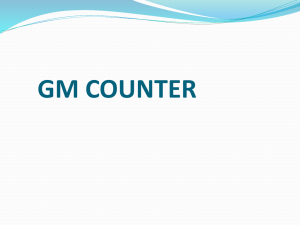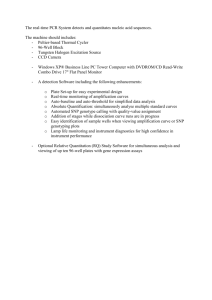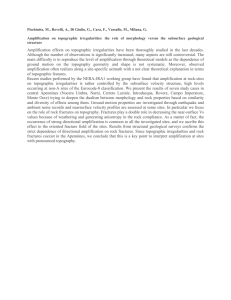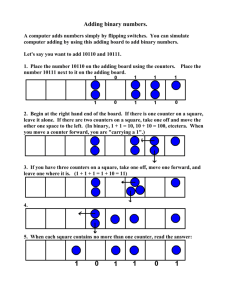GAS A M P L I F I C...
advertisement
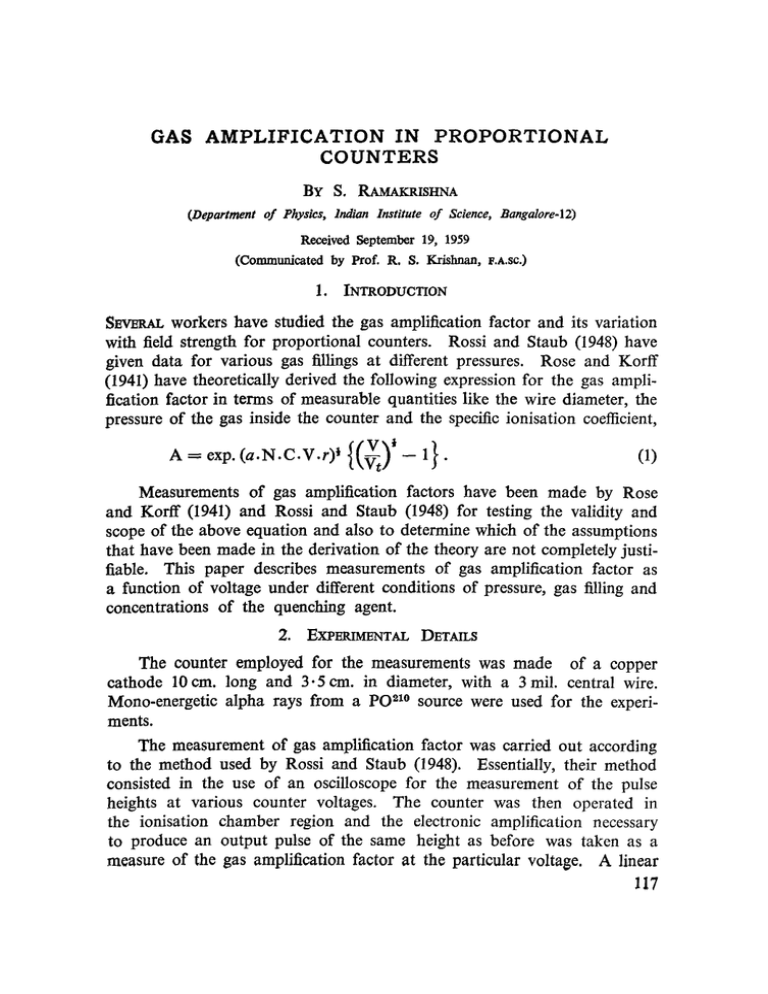
GAS A M P L I F I C A T I O N
IN P R O P O R T I O N A L
COUNTERS
BY S. RAMAKRISHNA
(Department of Physics, lndian Institute of Science, Bangalore-12)
Received September 19, 1959
(Commtmicated by Prof. R. S. Krishnan, I~.A.SC.)
1. INTRODUCTION
SE~gAL workers have studied the gas amplification factor and its variation
with ¡
strength for proportional counters. Rossi and Staub (1948) have
given data for various gas ¡
at different pressures. Rose and Korff
(1941) have theoretically derived the following expression for the gas amplification factor in terms of measurable quantities like the wire dŸ
the
pressure of the gas inside the counter and the specific ionisation coefficient,
A -~ exp. ( a . N . C . V . r ) ' { ( ~ t ) t -- 1 } .
(1)
Measurements of gas amplification factors have been made by Rose
and Korff (1941) and Rossi and Staub (1948) for testing the validity and
scope of the above equation and also to determine which of the assumptions
that have been made in the derivation of the theory ate not completely justifiable. This paper describes measurements of gas amplification factor as
a function of voltage under different conditions of pressure, gas filling and
concentrations of the quenching agent.
2.
EXPERIMENTAL DETAILS
The counter employed for the measurements was made of a copper
cathode 10 cm. long and 3.5 cm. in diameter, with a 3 mil. central wire.
Mono-energetic alpha rays from a PO 21~ source were used for the experiments.
The measurement of gas amplification factor was carried out according
to the method used by Rossi and Staub (1948). Essentially, their method
consisted in the use of an osciUoscope for the measurement of the pulse
heights at various counter voltages. The counter was then operated in
the ionisation chamber region and the electronic amplification necessary
to produce an output pulse of the same height as before was taken as a
measure of the gas amplification factor at the particular voltage. A linear
117
118
S. ~ S m , ~ A
amplifier based on a circuit given by Elmore and Sands (1949) was constructed and used for the present measurements. The amplifier linearity for
input pulses ranging from 100 t~v (which was the minimum detectable signal
above the noiselevel)to about 1 V (corresponding to a ratio of 1:10,000
in input pulse heights) was checked by standard methods.
The eounter was ¡
with the gas to be studied and plaeed in a weUshielded box to avoid pick-up. The pulses from the counter were displayed
on the oscilloseope sereen after amplification. When the counter was
operating in the ionisation chamber region, which is indicated by the pulse
height remaining appreciably constant with changes in applied voltage,
the pulse height on the oscilloscope screen was measured. The voltage was
then increased in steps and the pulse height was adjusted to be the same as
when the counter was operating in the ionisation chamber region, by means
of the attenuator. The amplification factor corresponding to a given voltage
was obtained by noting the attenuation that was introduced.
Ordinarily, such measurements would be limited by the setting in of
space-charge effects. It has been shown (Venkatasubramanian, 1957) that
space-charge effects become considerable at values of A as low as 103 for
alpha particles whose entire track is assumed to be confined within the
counting volume. Rossi and Staub have also cortfined their values to less
than 103.
In the following experiments, this upper limit has been pushed up by
making the alpha particle spend only part of its track inside the counting
volume. The total ionisation is consequently less and hence space-charge
limitations set in at higher values of A. However, even this method cannot
be carried too lar, since if too small a portion of the track is spent inside
the counter the error in the accurate computation of the pulse size increases.
The author has therefore given values of A up to about 2,000 only.
3.
RESULTS
Experiments were carried out on 10~ and 2570 argon-ethane and argonCO2 mixtures. The results obtained are graphically represented in Figs. 1-3.
The critical voltages given in Table I indicate the onset of the Geiger
region. I t i s seen that the gas amplification values range up to 1,000 for
the argon-ethane mixture and the argon-CO2 mixture. The gas amplification curves show some interesting features and these are discussed in Table I.
4.
DISCUSSlON
(a) Effect of Pressure.--Figure 1 gives the variation of A with the applied
voltage for two different gas prCssures for argon-ethane counters. The
119
Gas Amplification in Proportional Counters
!
~OCm$
~bOcmS
,o
,ff"O
SxIc
~00
,oo
9;o
,.oo
,3;o
wOLTAG( I r237
,~o
FIO. I
2 g lOs,
txao ~
10%
25%
,;oo
t~
~
10 %
:0
s ~ m~
£
~
~SxtO
SXIO
* .~.2~ %
VOLI"aGi r voors)
vOLTAr~s ! VOLTS)
Fio. 2
FIO. 3
Pros. 1-3. Fig. I. Gas Ampli¡
vs. Voltage for Argon-Ethane Filling. Fig. 2.
Ga sAmplification vs. Voltage for Argon-Ethano FilHng. Fig. 3. Gas Amplification v s . Voltage
for Argon-COs Filling.
TABLE I
Gas filling
Argon + que~ching agent
10 cm.
l~ssurc
No.
Quenching Agent
%
Critical voltage
volts
CO~
Calle
l
0
880
880
2
I0
1,200
980
3
25
1,420
I,I00
120
S. RAMAKRISI-INA
curves drawn by the author are in general agreement with the results of
other workers. The increase in value of A at lower pressures is a result
of a decrease in the threshold voltage. At higher pressures, the increase
in A with voltage is less rapid since a/p does not increase as fast as it does
at lower pressures.
(b) Effect of Quenching Agent.--It is well known (Trost, 1937) that
the addition of a little quenching agent like ethyl alcohol results in a reduction of photo-emission and secondary electron emission in a Geiger counter.
The action of the quenching agent in a proportional counter is also similar.
The only difference is that in the former it prevents the setting in of a eontinuous discharge, while in the latter it prevents the spread of the discharge
along the central wire.
The manner in which a quenching agent suela as ethyl alcohol or methane
prevents photo-emission and secondary electron emission has been described
in detail by Korff and Present (1944). The de-excitation of excited atoms
or molecules in the counter, by means of photon emission, causes a spread
in the discharge. This is prevented by the organic quenching gas since
these normally have a continuous absorption band in the ultra-violet, in
which region the photon energies normally fall. Diatomic and monatomic
molecules, however, have stable and discrete electronic states and de-excite
predominantly by photo-emission or fluorescence. Secondary electron
emission tal(es place ir the energetic ions ate able to approach the cathode
to within a critical distance (Massey, 1930) usually of the order of 10-7 cm.
This is prevented by the quenehing agent by a charge exchange process,
A+ + (C2H5)
A + (C2H5)+
resulting in polyatomic molecules and not argon atoms to be incident on
the cathode. These pre-dissociate rather than cause secondary emission,
and even if in some cases they do liberate electrons, they are degraded in
energy and are not capable of causing large avalanches.
In view of the above considerations, it is evident that both ethane and
carbon dioxide will be suitable as quenching agents. This is borne out
by the fact that with only argon as the filling gas, the experimental curve
departs from the theoretical predictions (by showing a faster rise than is
expected) at gas amplification factors as low as 100, while with the addition
of ethane of carbon dioxide, the exponential rise is maintained up to values
of 2,000 for A. Argon-ethane counters have the desirable property of lower
operating voltages, but the gas amplification characteristic of an argonCO~ counter is more satisfactory in the sense that the rate of increase of A
with the applied voltage is not very rapid. Thus, both ethane and carbon
Gas Amplification in Proportional Counters
121
dioxide can be used with advantage as quenching vapours in proportional
counters.
(r Effect of Concentration.--At low gas amplification factors and at
low concentrations of the quenching agent, there is hardly any effect at all
on the gas ampli¡
characteristic. Since none of the processes for
the prevention of which the quenching agent is added are in operation at
low values of A, this is to be expected. At higher values of A, however,
the quenching agent prevents the pass-over into the Geiger region, for
reasons given above. Table I gives the voltages at which Geiger discharge
sets in, for various concentrations of the quenching agent. Carbon dioxide is found to be more effective in this process since its ionisation potential is nearer to that of argon and hence electron transfer is expected to be
more efficient. A further reason is that in accordance with the theory, the
addition of appreciable quantities of quenching agent changes the value
of the term a, which is a characteristic of each gas (Curran and Craggs, 1949)
in the expression for the gas ampli¡
factor.
Quantitatively, as seen from the curves, the slope at low gas amplification
factors does not alter appredably for concentrations up to about 30~ in
the case of ethane and 20~ for COs. The characteristics actually coincide
in the low gas ampli¡
region, within the experimental accuracy. This
has also been observed by Colli and Facchini (1952) for low concentrations
of C02.
5. SUMMAXY
The variation of gas amplification with applied voltage is an important
characteristic of a proportional counter. Results of studies on gas amplification for gas fillings of argon quenched with ethane and carbon dioxide
ate given. The cffccts of (a) pressure, (b) quenching agent and (0 concentration on A are discussed briefly.
6.
ACKNOWLEDGEMENT
I thank Professor R. S. Krishnan for guidance and suggestions. I also
thank Dr. V. S. Venkatasubramanian for helpful discussions.
7.
1. Colli, L. and Facr
U.
..
Physica, 1952, 18, 1272.
Counting Tubes, Butterworths, 1949.
..
Electronics~Experimental Techniques, McGraw-Hill, 1949.
2. Cutran, S. C. and Craggs,
J.D.
3. Elmore and Sands
REFERENCES
S. RAMAZ~SHNA
Phys. Rey., 1944, 65, 274.
4. Korlf, S. A. and Present,
R.D.
5.
Massey, H. S.W.
..
Proc. Camb. Phil. Soc., 1930, 26, 386.
6. Rose, M. E. and Korlf, S. A. Phys. Rey., 1941, 59, 850.
7. Rossi, B. and Staub, H.
..
Ionisation Chambers and Counters, McGraw-Hill, 1948.
8. Trost, A.
..
Zeits. f. Phys., 1937, 105, 399.
Jour. Ind. lnst. ScL, 1957, 39, 125.
9. Venkatasubramanian, V. S.
190-60 Printed at the B91
Press, Ban8alorr City, by T. K. Balakrishnan, Superintendent,
and Published by The Indian Academy of Sr
Ban8alorc.

